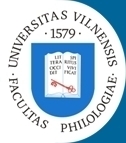Semantics of productively formed regular derivatives in contextual use: the case of the Latvian agentive suffix -tāj-
Anotacija
Productive derivation is a generic means for satisfying specific naming needs that arise in concrete contexts and situations. The semantics of productively formed regular derivatives as context-free pairings of form and meaning (i.e. taken out of context, as ‘dictionary words’), is therefore necessarily schematic or underspecified (we will call this ‘minimal derivational semantics’). In actual language use, when deriving a novel productively formed derivative or invoking a previously circulating derivative as a ‘novel’ productive formation, the minimal derivational semantics is enriched to fit specific naming needs. Latvian has a rich system of productive word formation featuring, primarily, suffixation, prefixation, some circumfixation, a few derivational endings, and compounding (see, e.g., Kalnača, Lokmane 2021). The agentive nominalising suffix -tāj- is one of the most productive category-changing derivational suffixes in contemporary Latvian. The generic derivational meaning of the word-formation pattern Vsuffixal + -tāj- → N is traditionally broadly defined as ‘a bearer of a property expressed in relation to an action’ (Soida 2009), which, in this particular wording, allows for different semantic roles (e.g., agent, experiencer, instrument, causer) and even syntactic arguments (e.g., S or Obj ‘smth to do V with’) of a -tāj- noun in relation to the source verb. In this study, we argue that the semantic diversity of -tāj- derivatives arises mostly due to contextual specification, i.e. adjusting the generic derivational meaning of the word-formation pattern to specific naming needs, while at the highest level it is very simple. We then suggest five contextual semantic features to describe the ways in which the rich contextual semantics of -tāj- derivatives differs from their minimal derivational semantics. It should be emphasised that our focus has been on studying concrete contextual uses and registering any semantic differences that we happen to encounter without attempting to build them into existing syntactic or lexical semantic frameworks, although the model of the semantics of derivationally and semantically complex words has been inspired by Lieber’s (2004; 2017) ideas. The derivatives used in this study were extracted from the The Balanced Corpus of Modern Latvian LVK2018 while contextual uses were analysed based on contexts found in the The Latvian National Corpora Collection.

Svetainės turinį galima naudoti nekomerciniais tikslais, vadovaujantis CC-BY-NC-4.0 tarptautinės licencijos nuostatomis.
 BALTISTICA
BALTISTICA